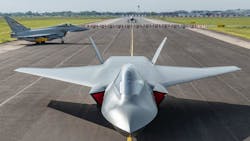Britain's future 6th-generation Tempest stealth jet fighter may rival U.S. F-35 and other advanced jets
LONDON – The Tempest stealth jet fighter was unveiled alongside a new combat air strategy document marking the United Kingdom’s reorientation to preparing for high-intensity conflicts and the danger posed by modern anti-aircraft weapons. The National Interest reports. Continue reading original article
The Military & Aerospace Electronics take:
26 Nov. 2019 -- The Tempest will supposedly boast a laundry list of sixth-generation technologies such as being optionally-manned, mounting hypersonic or directed energy weapons, and capability to deploy and control drone swarms. However, it may also represent a Brexit-era gambit to revive defense cooperation with Germany and France.
Design will supposedly be finalized in the early 2020s, with a flyable prototype planned in 2025 and production aircraft entering service in 2035, gradually replacing the RAF’s fourth-generation Typhoon fighters and complementing F-35 stealth jets. This seventeen-year development cycle is considered ambitious for something as complicated and expensive as a stealth fighter.
Surplus electricity may be of particular interest for powering directed energy weapons, which could range from lasers to microwaves. The U.S. Air Force plans to test a defensive anti-missile laser turret for its jets in the early 2020s, but the Tempest presentation mentions using direct energy weapons for ‘non-kinetic’ purposes, which may imply disrupting or damaging adversary sensors.
Related: Tempest 6th-generation jet fighter mock-up unveiled at Farnborough
Related: 6th-generation jet fighters may involve hypersonic technology, artificial intelligence (AI)
John Keller, chief editor
Military & Aerospace Electronics

